RF parameter planning for 5G involves determining various engineering parameters essential for optimizing network performance. This includes 5G massive MIMO beams, Beamwidth Definition, azimuth, Antenna Altitude Planning, Broadcast Beam Planning, Downtilt Planning for 5G and Power Planning. The process aims to ensure adequate coverage, capacity, and quality of service across the network.
RF Parameter Planning of 5G.
1. 5G Massive MIMO Beams.
Massive Multiple-Input Multiple-Output (MIMO) is a core feature of 5G technology, significantly enhancing signal coverage and reducing interference. By utilizing beamforming techniques, massive MIMO creates highly precise user-level ultra-narrow beams. The wave energy in these beams adjusts dynamically according to the user’s location, providing better performance compared to traditional wide-beam antennas.

Static and Dynamic Beams
Massive MIMO antennas in 5G networks can generate both static and dynamic beams, each serving different purposes:
Static Beams:
Cell-Level Static Beams are used for transmitting cell data in the Synchronization Signal Block (SSB), Physical Downlink Control Channel (PDCCH), and Channel State Information Reference Signal (CSI-RS). These beams cover the entire cell using a time-division scanning method, ensuring broad coverage for essential control and synchronization signals.
Dynamic Beams:
UE-Level Dynamic Beams are specifically used for User Equipment (UE) data in the Physical Downlink Shared Channel (PDSCH). These beams are dynamically formed based on the UE’s channel environment, optimizing the signal quality and user experience.
Beam Coverage and Configuration
Static Broadcast Beams cover the entire cell using a narrow-beam polling mode, transmitted over appropriate time-frequency resources. The configuration of broadcast beams can be adjusted based on the specific coverage scenario, ensuring efficient resource utilization.
Dynamic Traffic Beams employ dynamic beamforming, adapting in real-time to the user’s location and channel conditions. Unlike static beams, traffic beams cannot be customized and are inherently flexible to meet varying demand.
Downtilt Planning
There are significant differences in downtilt planning between massive MIMO beams and traditional wide beams:
- Traditional Wide Beams: Downtilt planning for traditional wide beams involves setting a fixed vertical angle to control the coverage area and minimize interference.
- Massive MIMO Beams: For massive MIMO beams, downtilt planning is more complex due to the dynamic nature of the beams. The downtilt needs to be adjusted to optimize the performance of ultra-narrow beams, taking into account the specific coverage and interference characteristics of each beam.
2. Beamwidth Definition
The beamwidth, whether horizontal or vertical, is defined as the angle between the half-power (-3 dB) points of the beam’s envelope. This measure is crucial for understanding and designing the beam’s coverage and interference characteristics.
3. Azimuth Planning.
5G Massive MIMO Antenna Azimuth Planning
Azimuth Direction.
The azimuth direction is crucial in antenna planning and is defined as the midpoint of the horizontal beamwidth of the antenna. Proper azimuth planning ensures optimal signal coverage and quality.
Principles of Massive MIMO Antenna Azimuth Planning
5G RAN2.0 supports remote azimuth adjustments, which allows for fine-tuning during network optimization. Initially, it’s recommended to set the azimuth to 0° during network planning.
DT Scenarios:
During the initial stage of 5G network construction, the primary goal is to meet Drive Test (DT) requirements and optimize street coverage. The azimuths of legacy 3G/4G sites are usually set for continuous networking. However, 5G sites should have azimuth planning focused on street coverage rather than merely sharing azimuths with existing 3G/4G sites.
Continuous Coverage:
- High Co-Site Ratio: If an operator has an existing 3G/4G network with a high co-site ratio, the initial 5G antenna azimuths should be configured by referring to the azimuths of the 3G/4G antennas in live networks.
- Low Co-Site Ratio or New Operators: For new operators or those with a low co-site ratio, the initial antenna direction should follow a standard clover-shaped pattern. Antennas should be directed at 30°, 150°, and 270° to avoid the waveguide effect on long, straight streets.
- Network Perspective: Antenna azimuths should be planned from a network-wide perspective. Ensuring sufficient coverage and consistency in three-sector azimuths across an urban area is essential, with some regional fine-tuning allowed.
- Fringe and Backbone Areas: In rural-urban fringes, transportation backbones, or isolated suburban sites, azimuths should be adjusted based on specific coverage objectives.
- Traffic Hotspots: Directing the main lobes of antennas towards areas with dense traffic can enhance signal strength and call quality. For drive tests, directing the main lobes towards streets can improve signal quality.
- Overlap Management: The coverage overlap between neighboring sectors should not be excessively deep.
- Sector Angles: The angle between directions of neighboring sectors within the same base station should be at least 90°.
- Avoiding Overshoot: In densely populated urban areas, avoid directing main lobes towards relatively straight streets to prevent overshoot coverage.
Adjustable Azimuth:
5G RAN2.0 supports adjustable azimuths for broadcast beams but not for dynamic beams used in traffic channels. The control channel beam azimuth can be adjusted in 1° increments. However, certain beam scenarios, such as beam scenario 1, 6, and 12, do not support digital azimuth adjustment due to the horizontal scanning range limits. For other scenarios, remote digital azimuth adjustment is possible.
Initially, azimuths are adjusted mechanically during network planning. Subsequent optimization utilizes the adjustable azimuth feature to enhance network performance.
4. Antenna Altitude Planning.
Effective antenna altitude planning is crucial for optimizing coverage and signal quality in different deployment environments. The principles of antenna altitude planning are based on the specific requirements of urban and rural areas, as well as the need for co-site deployment with existing 3G/4G infrastructure.
Urban Areas
- Standard Effective Altitude: The effective altitude for antennas in urban areas is typically set at 25 meters. This height is chosen to balance the need for broad coverage while minimizing interference from buildings and other structures commonly found in urban environments.
Rural Areas
- Standard Effective Altitude: In rural areas, antennas are usually installed at an altitude of 40 meters. This higher elevation helps extend the coverage range across open areas, where there are fewer obstructions but where broader signal propagation is required to cover larger geographical areas.
Co-Site Deployment with 3G/4G
- Installation Above Existing Antennas: When 5G antennas (AAUs) are deployed on the same site as existing 3G/4G antennas, it is recommended that the 5G antennas be installed above the 3G/4G antennas if space allows. This approach helps to maximize the efficiency of the 5G signal by minimizing interference and optimizing line-of-sight transmission.
Considerations for Antenna Altitude Planning
- Coverage Optimization: The chosen altitude should optimize signal coverage and quality, taking into account the specific topography and urban density of the deployment area.
- Interference Management: Proper altitude planning helps to reduce interference from surrounding structures and other signal sources, ensuring a cleaner and more reliable signal.
- Co-Site Efficiency: In co-site deployments, placing 5G antennas above existing 3G/4G antennas can enhance the overall performance of both networks by reducing interference and ensuring that the more advanced 5G signals are not obstructed by the older infrastructure.
5. Broadcast Beam Planning.
5G RAN2.0 supports various antenna configurations to cater to different deployment scenarios. These configurations include 64T64R, 32T32R (16H2V and 8H4V), and 8T8R, each with specific broadcast beam scenarios designed to optimize coverage and performance based on the environment and network requirements.

Antenna Configurations and Beam Scenarios
64T64R AAUs:
- Support 17 types of beam configurations.
- Vertical beamwidth options: 6°, 12°, and 25°.
- 6° Beam: Single basic beam.
- 12° Beam: Composed of two basic beams.
- 25° Beam: Composed of four basic beams.
32T32R 16H2V AAUs:
- Support 5 types of beam configurations.
- Vertical beamwidth options: 6° and 12°.
- 6° Beam: Single basic beam.
- 12° Beam: Composed of two basic beams.
32T32R 8H4V AAUs:
- Support 17 types of beam configurations.
- Vertical beamwidth options: 6°, 12°, and 25°.
- 6° Beam: Single basic beam.
- 12° Beam: Composed of two basic beams.
- 25° Beam: Composed of four basic beams.
8T8R RRUs:
- Support only one default type of beam configuration.
- Horizontal and vertical beamwidths are the same as those of the 8T8R single-column antenna.
Recommended Configurations for Broadcast Beam Scenarios
- Low-Rise Buildings:
- Use beam networking with a vertical beamwidth of 6°.
- Recommended scenarios: SCENARIO_1 to SCENARIO_5.
- Middle-Rise Buildings:
- Use beam networking with a vertical beamwidth of 12°.
- Recommended scenarios: SCENARIO_6 to SCENARIO_11.
- High-Rise Buildings:
- Use beam networking with a vertical beamwidth of 25°.
- Recommended scenarios: SCENARIO_12 to SCENARIO_16.
- High Horizontal Coverage Requirements:
- Recommended scenarios: SCENARIO_1, SCENARIO_6, or SCENARIO_12 based on building height.
- This configuration improves beam gains and coverage at the cell edge.
- Fixed Interference Sources at Cell Edge:
- Recommended scenarios: SCENARIO_2, SCENARIO_3, SCENARIO_7, SCENARIO_8, or SCENARIO_13.
- These scenarios help to narrow down the horizontal coverage area and avoid interference.
- Isolated Buildings:
- Recommended scenarios: SCENARIO_4, SCENARIO_5, SCENARIO_9, SCENARIO_10, SCENARIO_11, SCENARIO_14, SCENARIO_15, and SCENARIO_16.
- These scenarios provide small horizontal coverage and are not suitable for continuous networks.
By selecting appropriate beam scenarios based on the deployment environment and specific coverage needs, network planners and rf optimizer can ensure optimal performance and efficient use of the 5G infrastructure.
Below table shows Beam scenarios.
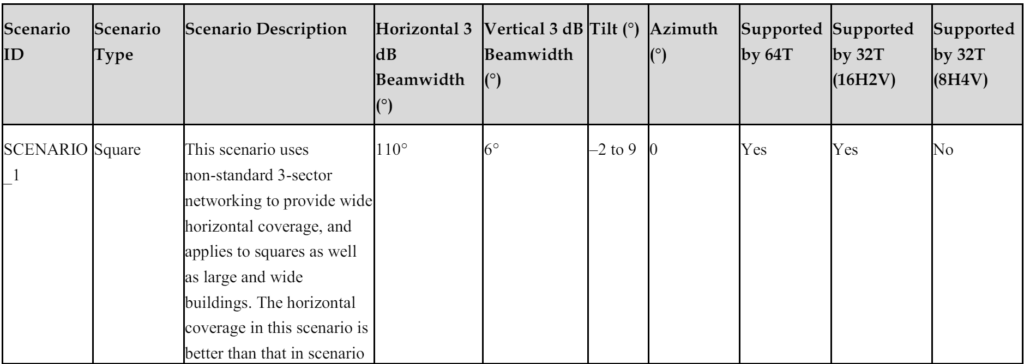
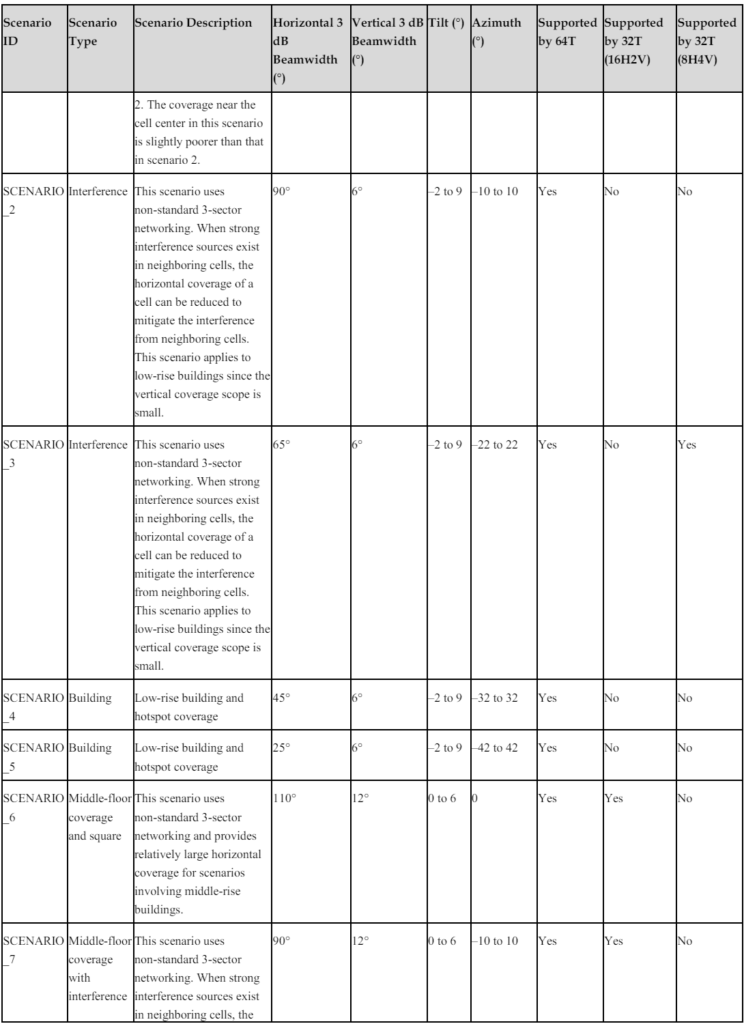
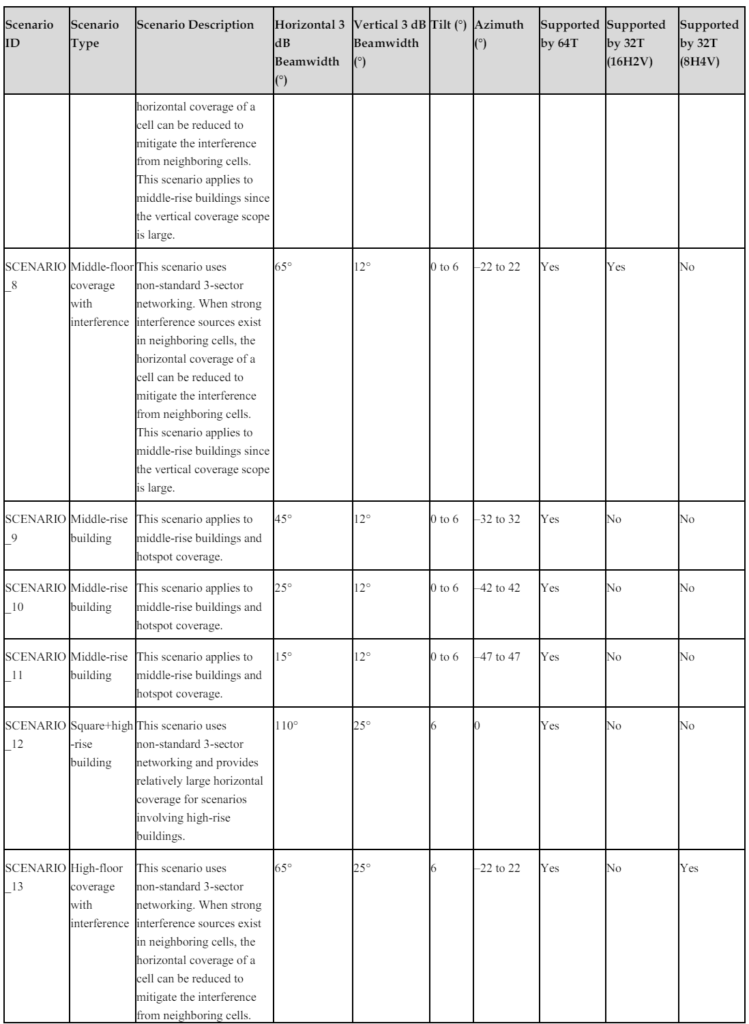
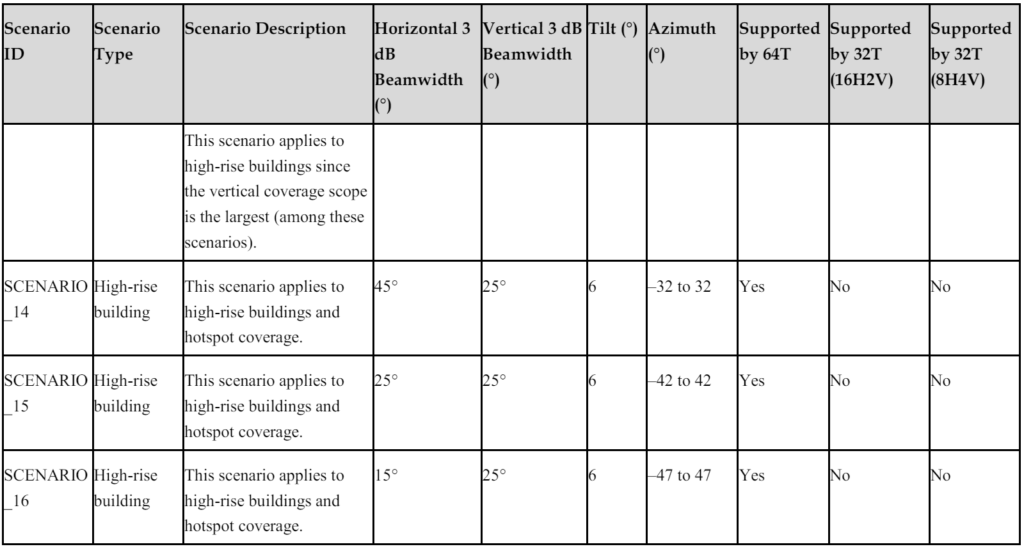
6. Downtilt Planning for 5G.
The downtilt of 5G massive MIMO beams is divided into three parts: mechanical downtilt, preset electrical downtilt, and adjustable electrical downtilt. The final downtilt is the combination of these components. This differs from traditional LTE wide-beam cells, which primarily use mechanical and electrical downtilt to ensure optimal coverage and suppress inter-cell interference.
5G Downtilt Definition
- Traditional Antennas: Only have a cell downtilt concept, and adjusting the downtilt changes both control and traffic beam downtilt.
- 5G Massive MIMO (MM):
- Common Beam Downtilt: Common beam downtilt = Mechanical downtilt + Adjustable electrical downtilt. Adjusting the common beam downtilt affects the coverage of common or control channels and the network camping of UEs.
- Traffic Beam Downtilt: Traffic beam downtilt = Mechanical downtilt + Preset electrical downtilt. Adjusting the traffic beam downtilt affects the PDSCH RSRP and throughput.

Components of Downtilt
Mechanical Downtilt:
- Adjusts both common and traffic beams.
- In 5G RAN1.0, the adjustment range is -20° to 20°.
Preset Electrical Downtilt:
- Provides a larger downtilt range for 5G AAU unit arrays.
- In 5G RAN2.0, the preset downtilt is set at 6°.
Adjustable Electrical Downtilt:
- Only supports the adjustment of the broadcast beam downtilt, not the dynamic beams for traffic channels.
- Control channel beam downtilt can be adjusted with granularity of 1° using MML parameter configuration.
- Default broadcast beam configuration and scenarios 1 to 11 support remote electrical downtilt adjustment. Scenarios 12 to 16 do not support this due to vertical scanning range limits.

5G Downtilt Planning Principles.
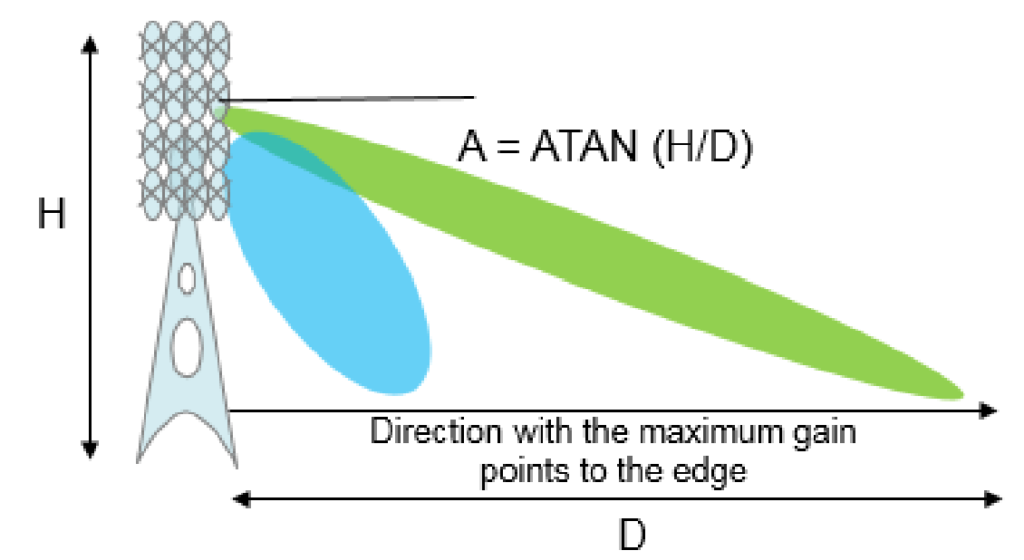
1. Optimize PDSCH Coverage:
Ensure the optimal coverage for the Physical Downlink Shared Channel (PDSCH).
2. Consistency in Downtilt:
Ensure control and traffic channels have the same downtilt by default (digital downtilt is 0), with adjustments allowed for control channel coverage.
3. Maximize Gain Direction:
For new 5G sites or vertical planes with multiple beam layers, the maximum gain direction should cover the cell edge.
4. Co-Site Deployment with Legacy Networks:
- For operators with high co-site ratios in legacy 3G/4G networks, follow the principle where the outer edge of the 3 dB beamwidth covers the cell edge to control coverage and suppress interference.
- Downtilt planning:
- Traffic Channels: 4G Mechanical Downtilt + Electrical Downtilt = 5G Mechanical Downtilt + Adjustable Electrical Downtilt (not in 5G RAN1.0) + 2°.
- Control Channels: 4G Mechanical Downtilt + Electrical Downtilt = 5G Mechanical Downtilt + Digital Downtilt + 2°.
5. Priority of Downtilt Adjustments:
Determine azimuth and mechanical downtilt with optimal CSI-RS RSRP which must be greater than adjust adjustable electrical downtilt for optimal SSB RSRP.
By following to these principles, network planners can ensure optimal performance, coverage, and interference management in 5G networks using massive MIMO technology.
7. Power Planning for 5G Networks.
In 5G RAN2.0, the power planning framework has evolved to enhance the efficiency and flexibility of power management across different signal components. Unlike previous generations, 5G RAN2.0 does not support static power configuration for key channels and signals such as PDSCH, SSB, PDCCH, Msg2, and CSI-RS. Instead, the configured power values are relative offsets to the reference power of DMRS, and power aggregation is used to boost signal strength for cell edge users.
- Static Power Configuration:
- Not Supported: 5G RAN2.0 does not allow static power configuration for PDSCH, SSB, PDCCH, Msg2, and CSI-RS.
- Relative Reference Power: The power configuration is set as an offset to the relative reference power of DMRS. The reference power is the average power of each Resource Element (RE) in the carrier.
- Default Value: The default offset value is 0, which corresponds to the average power of each RE.
- Power Aggregation for Cell Edge Users:
- Intra-Carrier Power Aggregation: The PDSCH supports intra-carrier power aggregation to enhance signal strength for users at the cell edge.
- Configurable Aggregation Value: The power aggregation value can be configured to optimize signal quality. By default, this value is set to 0 (No Aggregation).
Read Also: What is PCI Planning and Design in LTE?